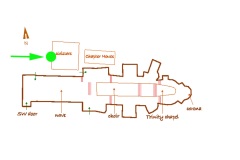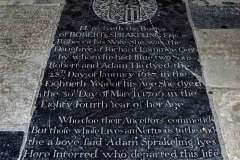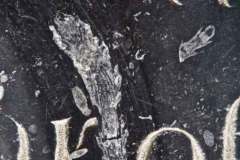Carboniferous Limestone is a collective term for the succession of limestones occurring widely throughout Great Britain and Ireland that were deposited during the Dinantian Epoch of the Carboniferous Period. These rocks formed between 363 and 325 million years ago.
Carboniferous Limestone is a sedimentary rock made of calcium carbonate. It is generally light-grey in colour, and is hard and compact. It was formed in a warm, shallow tropical sea teeming with life. The rock is made up of the shells and hard parts of millions of sea creatures encased in a carbonate mud. Corals, brachiopods and crinoids are very much in evidence as components of Carboniferous Limestone; indeed the rock is full of fossils.
The Carboniferous Limestone memorial pictured above lies in the floor of the Great Cloister west walk. It can be found close to the Dick Shepherd wall memorial. The ledger stone is a black limestone, the darker colouration arising from the quantity of finely disseminated organic carbon present. The memorial is to the Sprakeling family. The detailed image shows at centre a fossilised solitary coral.
Much of the Belgian Black Marble is of Carboniferous age and this example could be continental in origin.



